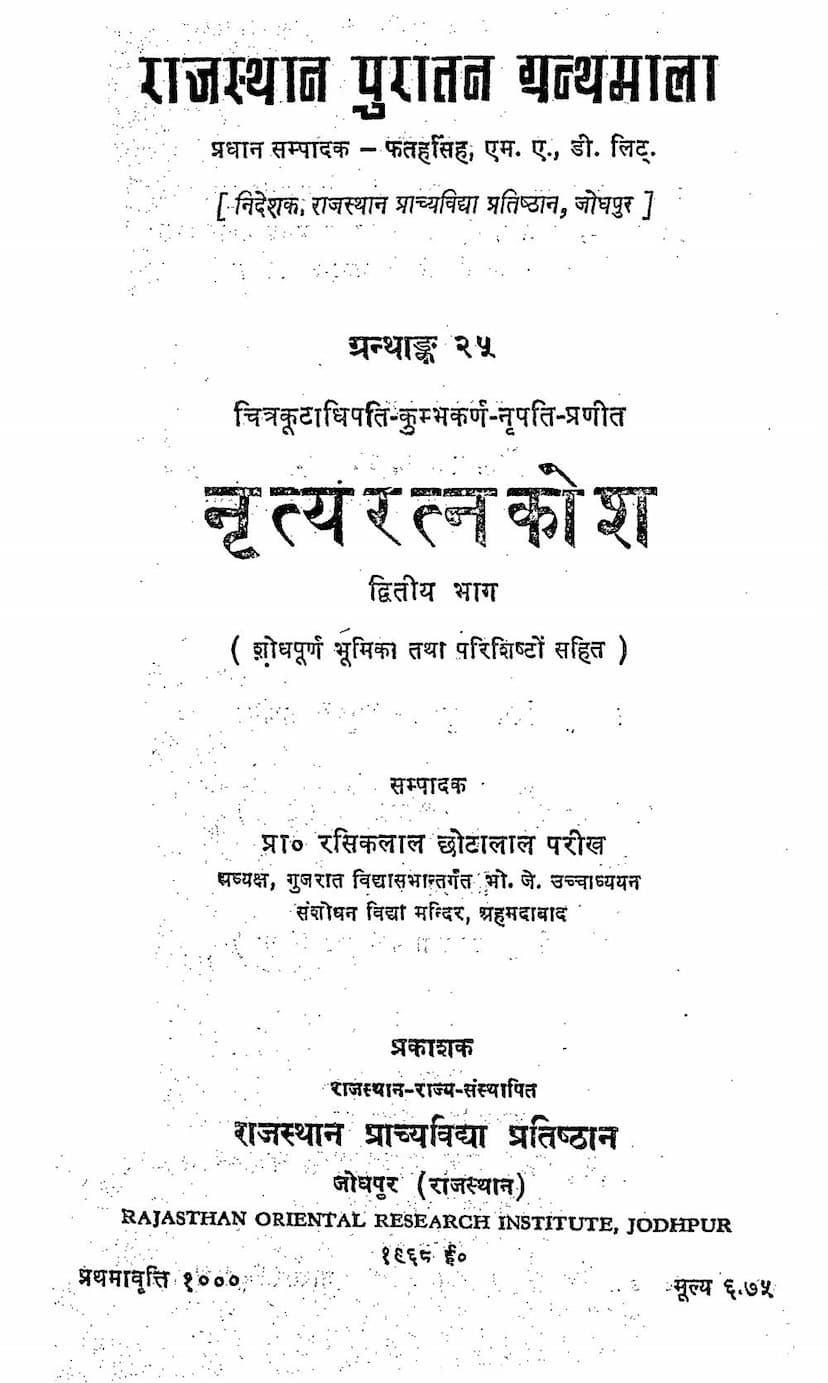Nrutyaratna Kosh Part 02
Added to library: September 2, 2025

Summary
Here's a comprehensive summary of the Jain text "Nrutyaratna Kosh Part 02" by Rasiklal C Parikh, based on the provided information:
Book Title: Nrutyaratna Kosh Part 02 (नृत्य रत्न कोश - द्वितीय भाग) Author: Rasiklal C Parikh (प्रा० रसिकलाल छोटालाल परीख) Publisher: Rajasthan Prachyavidya Pratishthan Jodhpur (राजस्थान प्राच्यविद्या प्रतिष्ठान, जोधपुर) Publication Year: 1968 (वि० सं० २०२४ / ई. १९६८)
Overall Context: This book, "Nrutyaratna Kosh Part 02," is a critical edition and continuation of the first part. It is a significant portion of a larger monumental work titled Samgitaraja (संगीतराज), also referred to as Samgita-mimamsa (संगीतमीमांसा), attributed to Maharana Kumbhakarna (महाराणा कुम्भ). Samgitaraja is described as a massive work comprising 16,000 verses and is divided into five "Ratnakoshas" (Treasuries):
- Pathyaratnakosha (पाठ्यरत्नकोश) - on vocal recitation.
- Gitaratnakosha (गीतरत्नकोश) - on singing.
- Vadyaratnakosha (वाद्यरत्नकोश) - on musical instruments.
- Nrutyaratnakosha (नृत्यरत्नकोश) - on dance (the subject of this volume).
- Rasaratnakosha (रसरत्नकोश) - on aesthetics and sentiments.
Key Features of Nrutyaratna Kosh Part 02:
- Scholarly Edition: The volume is presented as a "research-filled introduction and appendices" (शोधपूर्ण भूमिका तथा परिशिष्टों सहित), highlighting the academic rigor of the publication.
- Delayed Publication: The editorial note expresses regret for the 11-year delay in publishing this second part, despite the printing being completed in 1957.
- Focus on Dance: The Nrutyaratnakosha is dedicated to the art of dance, detailing various aspects from the classical Indian tradition as codified by Bharata Muni and further elaborated by Maharana Kumbha.
- Content of the Volume: The book meticulously details the subject matter related to dance, covering a vast array of technical terms, movements, postures, and theoretical aspects. The detailed table of contents indicates extensive coverage of:
- Ullasas (Chapters) and Parikshanas (Sections): The work is structured into multiple Ullasas, each further divided into Parikshanas.
- Karanas (Basic Dance Units): A significant portion of the text is dedicated to describing the 108 Karanas as defined by Bharata Muni, and how Kumbha might have classified or elaborated upon them. The text specifically mentions the classification into four types: Āveṣṭita, Udveṣṭita, Āvartita, and Parivartita.
- Body Parts and Movements: Detailed descriptions of hand gestures (hasta), limb movements (pratyanga, anga), neck (grīvā), arms (bāhu), waist (kaṭi), legs (jaṅghā), feet (pāda), and various facial expressions and eye movements (dṛṣṭi, tārakākarma, kapola, nāsā, prabhu, vāyu, adhara, danta, jihvā, civuka, vadana).
- Styles and Schools: Discussions on different styles of dance, including regional variations (deshī), and the classification of dance based on various parameters.
- Angaharas: Complex sequences of movements.
- Vrittis (Modes of Expression): Descriptions of four primary Vrittis – Bharati, Sattvati, Kaishiki, and Ārabhati.
- Kalasas (Specific Dance Figures): Detailed explanations of Vidyut Kalasa, Khadga Kalasa, Mriga Kalasa, Baka Kalasa, Manduka Kalasa, and Hamsa Kalasa.
- Pattralaxana: Characteristics of performers.
- Sampradaya: Traditions and lineages.
- Music and Rhythm: Integration of music and rhythmic cycles in dance.
Authorship Debate: A significant focus of the introduction is the debate surrounding the authorship of the Samgitaraja itself. While many manuscripts attribute it to Maharana Kumbhakarna (also referred to as Kumbhakarna, Kumbha Rana, or simply Kumbha), some manuscripts attribute it to Kalasena.
- The editor and scholars like Dr. Premalata Sharma strongly argue for Maharana Kumbha as the author, citing internal evidence and his known scholarly pursuits.
- The introduction explores the genealogical and historical details of Kalasena, suggesting he was a different individual, possibly from the Nasik region, and attempts to reconcile the conflicting manuscript evidence.
- The prevailing scholarly consensus presented favors Kumbhakarna due to stronger evidence.
Maharana Kumbhakarna's Significance: The introduction highlights Maharana Kumbhakarna not just as a ruler but as a prolific scholar, patron of arts and sciences, and a remarkable builder.
- Versatile Genius: He is credited with authoring several works in Sanskrit, including commentaries and treatises on music, dance, drama, and architecture.
- Cultural Patronage: His reign was a period of great artistic and cultural flourishing, with patronage extended to numerous scholars and artists.
- Architectural Achievements: His contributions as a builder are immense, including the famous Vijay Stambha (Tower of Victory) at Chittor, and numerous forts and temples.
- Military Prowess: The introduction details his military campaigns and victories against neighboring states and the Sultanates of Malwa and Gujarat, underscoring his strategic acumen and bravery.
- Complexity of Character: Kumbha's personality is portrayed as extraordinary, marked by intellectual curiosity, religious devotion, and strong leadership, but also showing signs of mental strain in his later years.
Critical Apparatus and Editorial Work: The edition is based on a comparative study of three manuscripts (Ms. A, Ms. B, Ms. C), with Ms. C providing significant variants. The editor, Prof. Rasiklal C Parikh, meticulously noted readings in footnotes and consulted other relevant texts like Bharata's Natyasastra and Sarngadeva's Samgitaratnakara to emend and validate the text. The publication also includes comprehensive indices of verses, technical terms, and referenced works/authors in the appendices.
Conclusion: "Nrutyaratna Kosh Part 02" is a scholarly publication that presents a detailed and critical study of the art of dance within the framework of Maharana Kumbhakarna's comprehensive work, Samgitaraja. It contributes significantly to the understanding of classical Indian dance, its theory, practice, and historical context, while also delving into the rich personality and achievements of its likely author, Maharana Kumbhakarna. The work emphasizes the integration of dance with broader philosophical and cultural aspects of Indian tradition.